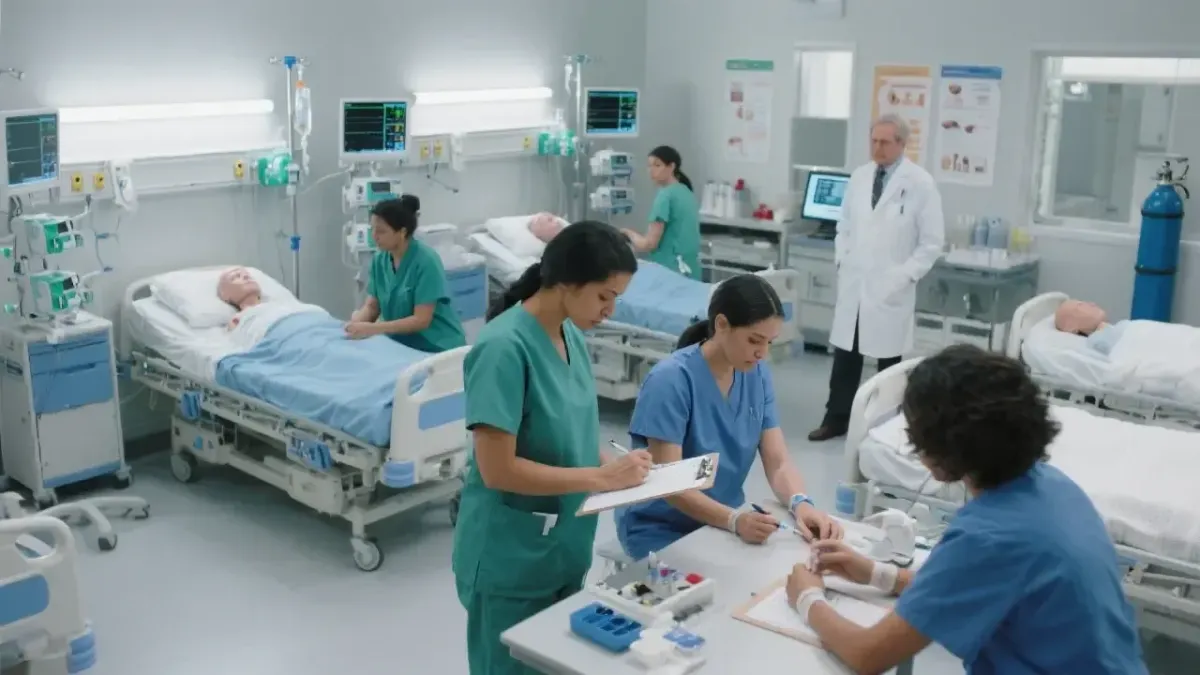The Hidden Crisis at the Bedside: Why New Nurses Need More Than a Diploma to Keep Patients Safe
Date published: August 22, 2025

Every day, thousands of newly graduated nurses walk onto hospital floors, carrying fresh degrees and genuine intentions to provide excellent patient care. Yet beneath this hopeful surface lies a troubling reality that healthcare leaders can no longer ignore: many of these well-meaning professionals are not adequately prepared for the complex realities of bedside nursing practice, creating significant patient safety risks that demand immediate transformation.
The Evidence Is Clear: We Have a Practice Readiness Crisis
Recent research reveals an alarming gap between nursing education and practice readiness. Studies consistently demonstrate that new graduate nurses struggle with critical competencies essential for safe patient care. Key findings show that practice readiness gaps can be attributed to ineffective communication skills, inability to navigate complex clinical environments, insufficient knowledge about comprehensive patient care, and lack of experience functioning effectively within healthcare teams.
The most concerning deficit identified in multiple research studies is the lack of clinical judgment skills – perhaps the most critical competency for ensuring patient safety. When nurses cannot synthesize complex patient information, prioritize care needs, and make sound clinical decisions under pressure, patients suffer the consequences through increased nursing errors and delayed recovery times.
The Patient Safety Connection We Cannot Ignore
The relationship between nursing practice readiness and patient safety is not theoretical – it's a documented reality with measurable consequences. Research demonstrates that when new nurses are unprepared for practice, the direct results include increased incidence of nursing errors, delayed patient recovery, and compromised quality of care delivery. These outcomes represent more than statistics; they reflect real patients experiencing preventable harm due to inadequate nursing preparation.
The current healthcare environment intensifies these risks. With increasing patient complexity, shorter hospital stays, and higher acuity levels across all care settings, the margin for error continues to shrink. Nurses who lack robust clinical judgment skills and comprehensive practice readiness cannot adapt quickly enough to prevent adverse events, creating a cascade of safety concerns that ripple throughout healthcare systems.
Beyond Individual Preparedness: The Systems Challenge
While it's tempting to frame this as simply an individual competency issue, the research reveals a more complex reality. Practice readiness involves not just individual nurse capabilities, but the "receptivity" of clinical environments to support new graduates during their critical transition from student to clinician. This suggests that transformation requires coordinated efforts across both educational preparation and practice environment support systems.
The evidence shows that practice readiness encompasses cognitive capabilities (clinical reasoning and decision-making), clinical capabilities (technical skills and procedures), professional capabilities (communication and teamwork), and self-efficacy (confidence and adaptability). Deficits in any of these areas create vulnerabilities that can compromise patient safety, yet traditional nursing education often inadequately addresses the integration of these complex competencies in real-world practice scenarios.
The Transformation Imperative
Healthcare organizations can no longer rely on hope and good intentions to bridge the practice readiness gap. The evidence demands systematic transformation across multiple domains:
Enhanced Clinical Judgment Development: Nursing education must prioritize clinical reasoning through simulation-based learning, case-based instruction, and extensive practical application opportunities that mirror real-world complexity. Students need repeated exposure to clinical decision-making scenarios that develop pattern recognition and critical thinking skills before they assume independent practice responsibilities.
Comprehensive Transition Support: Healthcare organizations must implement robust transition-to-practice programs that extend beyond basic orientation. These programs should include structured mentorship, gradual assumption of responsibilities, regular competency validation, and ongoing feedback mechanisms that support new graduates through their critical first year of practice.
Collaborative Educational Models: The artificial separation between academic preparation and clinical practice must end. Healthcare organizations and nursing schools need to develop true partnerships that ensure educational experiences align with current practice realities and emerging safety requirements.
A Call for Courageous Leadership
The research is unambiguous: current approaches to nursing education and transition support are insufficient for ensuring patient safety in today's complex healthcare environment. This is not about blame – it's about recognition that we must do better for both our patients and our nursing workforce.
Healthcare leaders, nurse educators, and policy makers have a moral imperative to act on this evidence. Every day we delay meaningful transformation, we accept preventable patient harm as an unfortunate but inevitable consequence of inadequate preparation systems.
The solution requires courage to challenge traditional approaches, investment in evidence-based educational innovations, and commitment to sustained collaboration between academia and practice. Most importantly, it requires acknowledgment that patient safety depends not just on having enough nurses, but on having nurses who are truly prepared to provide safe, competent care from day one.
The evidence for change is compelling. The question is whether we have the collective will to act before another patient experiences preventable harm due to inadequate nursing practice readiness. The time for transformation is now – our patients deserve nothing less.
Ready to Transform Nursing Practice at Your Organization?
If you're a healthcare leader committed to bridging the practice readiness gap and enhancing patient safety through evidence-based nursing education and transition support, we can help. Our consulting and education platform provides comprehensive solutions for developing clinical judgment, implementing effective transition programs, and creating collaborative educational models that prepare nurses for real-world practice.
Learn more about our proven approaches and how we can partner with your organization to transform nursing care at the bedside.
Visit https://drjuliesiemers.com/ to explore our resources and consulting services designed specifically for healthcare organizations ready to make meaningful change.
Let's work together to ensure every nurse is truly prepared to provide safe, competent care from day one.
#Nursing #Healthcare #PatientSafety #MedicalTraining #NursingStudents
The Hidden Crisis at the Bedside: Why New Nurses Need More Than a Diploma to Keep Patients Safe
Date published: August 22, 2025

Every day, thousands of newly graduated nurses walk onto hospital floors, carrying fresh degrees and genuine intentions to provide excellent patient care. Yet beneath this hopeful surface lies a troubling reality that healthcare leaders can no longer ignore: many of these well-meaning professionals are not adequately prepared for the complex realities of bedside nursing practice, creating significant patient safety risks that demand immediate transformation.
The Evidence Is Clear: We Have a Practice Readiness Crisis
Recent research reveals an alarming gap between nursing education and practice readiness. Studies consistently demonstrate that new graduate nurses struggle with critical competencies essential for safe patient care. Key findings show that practice readiness gaps can be attributed to ineffective communication skills, inability to navigate complex clinical environments, insufficient knowledge about comprehensive patient care, and lack of experience functioning effectively within healthcare teams.
The most concerning deficit identified in multiple research studies is the lack of clinical judgment skills – perhaps the most critical competency for ensuring patient safety. When nurses cannot synthesize complex patient information, prioritize care needs, and make sound clinical decisions under pressure, patients suffer the consequences through increased nursing errors and delayed recovery times.
The Patient Safety Connection We Cannot Ignore
The relationship between nursing practice readiness and patient safety is not theoretical – it's a documented reality with measurable consequences. Research demonstrates that when new nurses are unprepared for practice, the direct results include increased incidence of nursing errors, delayed patient recovery, and compromised quality of care delivery. These outcomes represent more than statistics; they reflect real patients experiencing preventable harm due to inadequate nursing preparation.
The current healthcare environment intensifies these risks. With increasing patient complexity, shorter hospital stays, and higher acuity levels across all care settings, the margin for error continues to shrink. Nurses who lack robust clinical judgment skills and comprehensive practice readiness cannot adapt quickly enough to prevent adverse events, creating a cascade of safety concerns that ripple throughout healthcare systems.
Beyond Individual Preparedness: The Systems Challenge
While it's tempting to frame this as simply an individual competency issue, the research reveals a more complex reality. Practice readiness involves not just individual nurse capabilities, but the "receptivity" of clinical environments to support new graduates during their critical transition from student to clinician. This suggests that transformation requires coordinated efforts across both educational preparation and practice environment support systems.
The evidence shows that practice readiness encompasses cognitive capabilities (clinical reasoning and decision-making), clinical capabilities (technical skills and procedures), professional capabilities (communication and teamwork), and self-efficacy (confidence and adaptability). Deficits in any of these areas create vulnerabilities that can compromise patient safety, yet traditional nursing education often inadequately addresses the integration of these complex competencies in real-world practice scenarios.
The Transformation Imperative
Healthcare organizations can no longer rely on hope and good intentions to bridge the practice readiness gap. The evidence demands systematic transformation across multiple domains:
Enhanced Clinical Judgment Development: Nursing education must prioritize clinical reasoning through simulation-based learning, case-based instruction, and extensive practical application opportunities that mirror real-world complexity. Students need repeated exposure to clinical decision-making scenarios that develop pattern recognition and critical thinking skills before they assume independent practice responsibilities.
Comprehensive Transition Support: Healthcare organizations must implement robust transition-to-practice programs that extend beyond basic orientation. These programs should include structured mentorship, gradual assumption of responsibilities, regular competency validation, and ongoing feedback mechanisms that support new graduates through their critical first year of practice.
Collaborative Educational Models: The artificial separation between academic preparation and clinical practice must end. Healthcare organizations and nursing schools need to develop true partnerships that ensure educational experiences align with current practice realities and emerging safety requirements.
A Call for Courageous Leadership
The research is unambiguous: current approaches to nursing education and transition support are insufficient for ensuring patient safety in today's complex healthcare environment. This is not about blame – it's about recognition that we must do better for both our patients and our nursing workforce.
Healthcare leaders, nurse educators, and policy makers have a moral imperative to act on this evidence. Every day we delay meaningful transformation, we accept preventable patient harm as an unfortunate but inevitable consequence of inadequate preparation systems.
The solution requires courage to challenge traditional approaches, investment in evidence-based educational innovations, and commitment to sustained collaboration between academia and practice. Most importantly, it requires acknowledgment that patient safety depends not just on having enough nurses, but on having nurses who are truly prepared to provide safe, competent care from day one.
The evidence for change is compelling. The question is whether we have the collective will to act before another patient experiences preventable harm due to inadequate nursing practice readiness. The time for transformation is now – our patients deserve nothing less.
Ready to Transform Nursing Practice at Your Organization?
If you're a healthcare leader committed to bridging the practice readiness gap and enhancing patient safety through evidence-based nursing education and transition support, we can help. Our consulting and education platform provides comprehensive solutions for developing clinical judgment, implementing effective transition programs, and creating collaborative educational models that prepare nurses for real-world practice.
Learn more about our proven approaches and how we can partner with your organization to transform nursing care at the bedside.
Visit https://drjuliesiemers.com/ to explore our resources and consulting services designed specifically for healthcare organizations ready to make meaningful change.
Let's work together to ensure every nurse is truly prepared to provide safe, competent care from day one.
#Nursing #Healthcare #PatientSafety #MedicalTraining #NursingStudents
Monitoring and Reporting
Collecting and analyzing data on safety incidents to identify trends and areas for improvement.
Establishing Standards
Developing and enforcing safety protocols to ensure consistency and quality across healthcare organizations.
Promoting Education
Providing training and resources to healthcare professionals to enhance their knowledge and skills in patient safety.
Encouraging Transparency
Creating a culture where healthcare workers feel empowered to report errors and near-misses without fear of retribution.

Driving Innovation
Leveraging technology and research to implement cutting-edge solutions for patient safety challenges.

